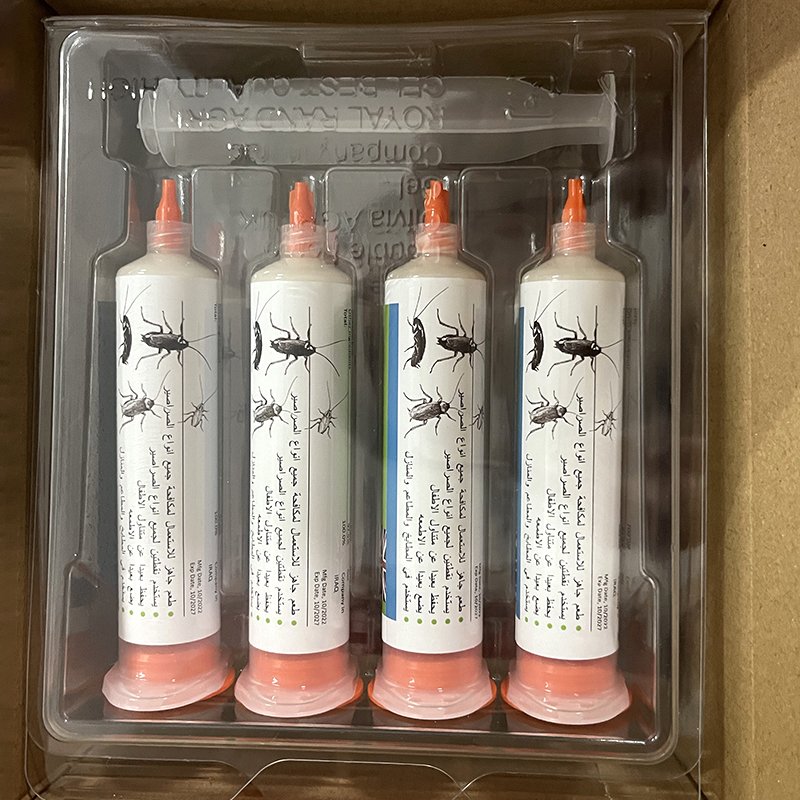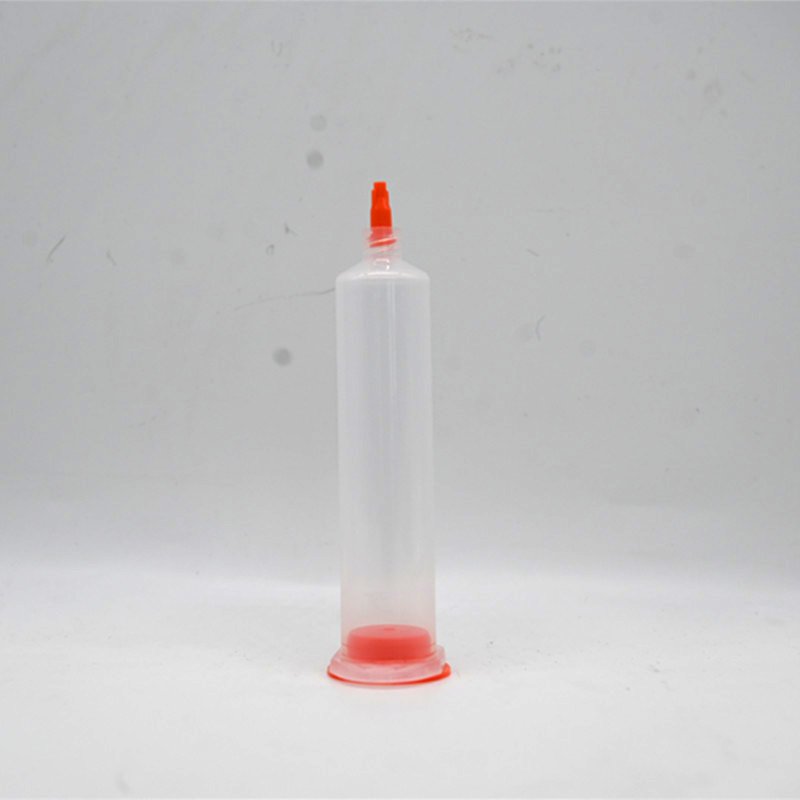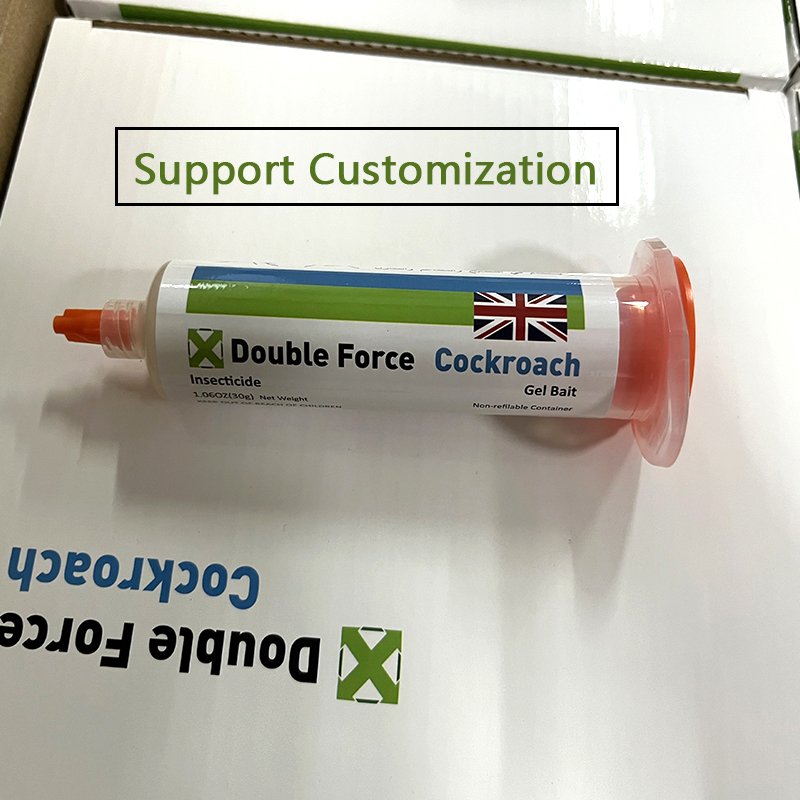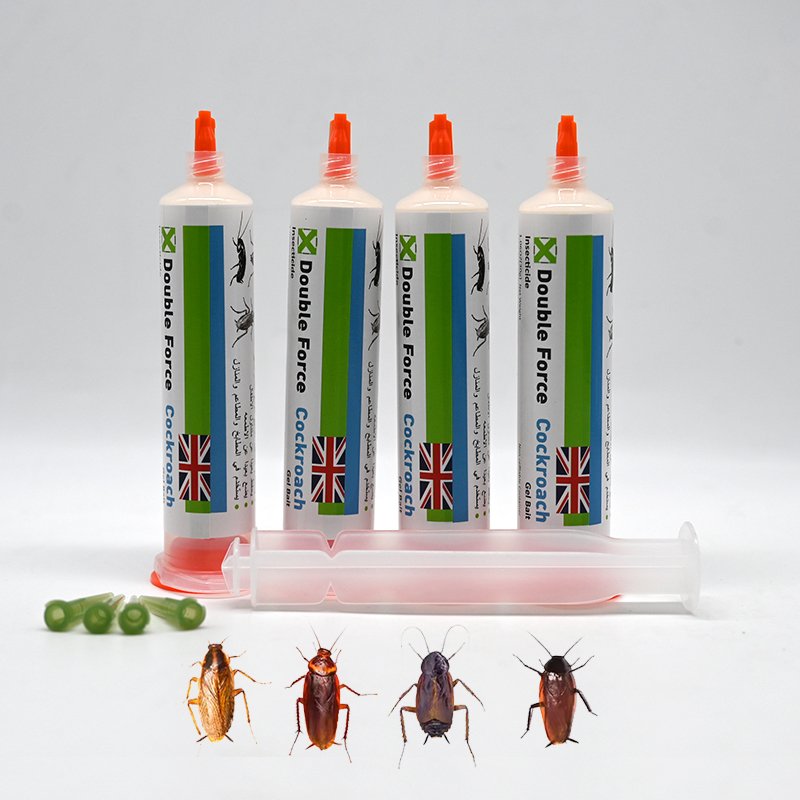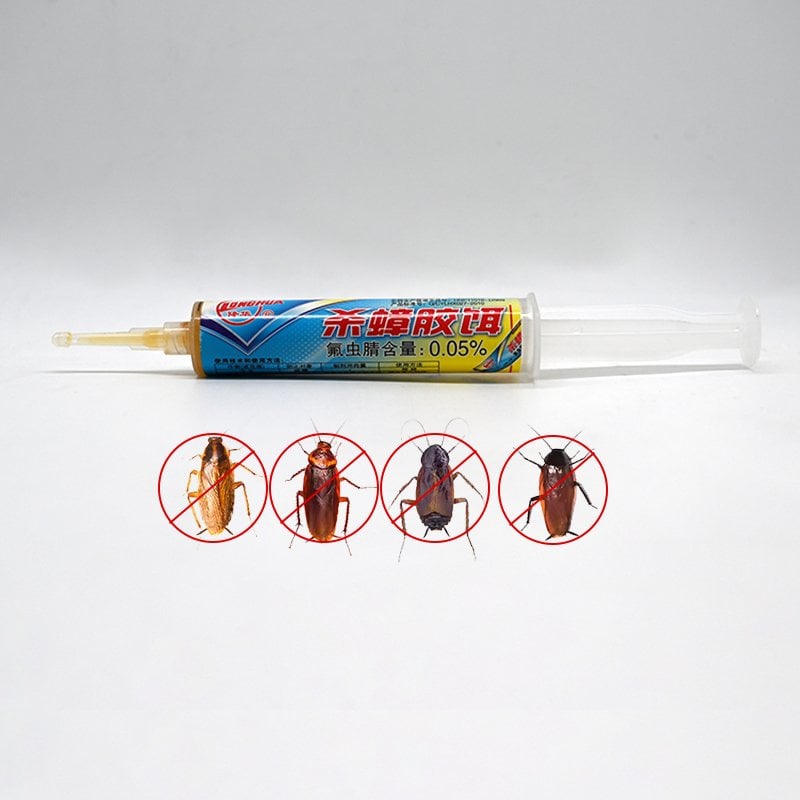How to Use Cockroach Gel (and Apply It Right)
If you want fast, durable control, technique beats volume. This guide explains how to use cockroach gel—and precisely how to apply cockroach gel—with pea-size dots or thin smears placed on hidden edges where roaches travel. You’ll get a clear, step-by-step workflow: surface prep around (not on) the bait, micro-dot sizing, spacing (30–45 cm, denser in hotspots), edge-run targeting (hinges, corners, toe-kicks, appliance backs), and a 48–72-hour refresh cadence to keep bait attractive and active.
Step-by-Step: How to Use Cockroach Gel
Surface prep (around, not on bait): Degrease edges and corners, dry the area, and remove crumbs—then stop; do not wipe the baited spots after placement.
Find the runways/harborages: Trace hinges, corners, cracks & crevices, toe-kicks/baseboards, under/behind appliances, pipe cut-outs—roaches edge-track these lines.
Dot size & form: Place pea-size dots (tight gaps can take rice-size micro-dots); use thin smears only for long, narrow cracks to maximize contact without overusing product.
Spacing & density: Start at 30–45 cm between dots along edges; compress to 15–20 cm in hotspots with fresh fecal specks, shed skins, or frequent sightings.
Height mix: Cover low (toe-kicks), mid (cabinet interiors), and high (upper cabinet corners/underside lips) to intercept nymphs and adults across vertical routes.
Keep it hidden, cool, and dry: Avoid food-contact surfaces and heat/steam zones (ovens, kettles, dishwashers).
Refresh & relocate: Recheck in 48–72 hours; replace consumed/dried/soiled dots and move untouched placements closer to new evidence.
No repellents over bait: Repellent sprays near gel suppress feeding; keep them in separate zones.
For anyone searching “cockroach gel how to use” or “cockroach killer gel how to use,” the method is the same: small, hidden, fresh, and frequently refreshed.
How to Apply Cockroach Gel Bait (Targeted Use)
For anyone asking how to apply cockroach gel bait, think “small, hidden, and on the edges.” Identify active runways and harborage mouths—hinges and rear seams inside cabinets, toe-kicks/baseboards, the underside lip of counters, behind/under refrigerators, dishwashers and ovens, and around pipe cut-outs—then place pea-size dots (or rice-size in tight gaps) every 30–45 cm; compress to 15–20 cm in hotspots with fresh fecal specks or frequent sightings. Keep gel off food-contact and wipe-down surfaces, and away from heat/steam that can dry or degrade bait. Do not spray repellent aerosols in bait zones; repellents suppress feeding—zone them elsewhere. After placement, check in 48–72 hours: ragged edges and shrinking dots mean feeding—top up with fresh micro-dots; untouched dots should be moved closer to new evidence or relocated along alternate edges. Replace any dried, greasy, or contaminated bait; many tiny placements outperform a few large blobs. Use sticky traps at fridge sides, toe-kicks, and pipe penetrations to map traffic and guide relocations. If you’re searching how to use cockroach gel bait or cockroach gel bait how to use, the winning formula is consistent: prep around (not on) the baited area, place micro-dots on shaded edge runs and harborage exits, refresh frequently, and never let competing food, grease, or water beat your bait.
Troubleshooting & Optimization
- No feeding on dots: Reduce competing food/grease/water; re-clean around (not on) placements. Shift dots closer to fresh fecal specks/harborage mouths, tighten spacing to 15–20 cm, and run placements along uninterrupted edge lines (hinges → corners → toe-kicks).
- Dots dry out or slump: Relocate from heat/steam (ovens, kettles, dishwasher vents) to shaded edges; replace dried/greasy/contaminated bait; use thin smears only for long, narrow cracks to minimize desiccation.
- Big blobs, few points: Break large globs into many pea-/rice-size micro-dots; breadth of coverage beats volume.
- Placed on visible/cleaned surfaces: Remove from food-contact and wipe-down zones; reposition to underside lips, interior corners, rear seams where cleaning won’t strip bait.
- Activity persists: Extend lines into appliance backs, pipe cut-outs, wall/floor penetrations, and—if in multi-unit buildings—along shared utility risers to intercept migration.
- Poor feedback loop: Add sticky traps at fridge sides, toe-kicks, and pipe penetrations; check 48–72 h, log where catches rise, and move dots toward those edges.
Where to Put
Kitchen (highest priority)
- Cabinetry: Inside hinge corners, along rear seams, around drawer runners, inside toe-kicks/baseboards.
- Sink & plumbing: Under-sink cabinet back corners and pipe cut-outs/penetrations.
- Appliances: Behind/under fridge, dishwasher, oven; along motor housings/side panels (not on hot parts).
- Counter underside: The underside lip/overhang—hidden from cleaning but on roach runways.
- Pantry: Shelf posts, backboard seams, door-frame bottom corners.
Bathrooms & Laundry
- Vanity: Interior hinges/corners, rear seams, pipe holes.
- Toilet/tub: Backside base corners, access panels, caulk edge gaps.
- Laundry/boiler: Rear feet, wall pass-throughs, drip-pan edges.
Pantry, Living Areas & Bedrooms
- Closets & storage: Shelf brackets, back panels, baseboard inside corners.
- Furniture/electronics: Back edges of TV stands, bookcases, sofa bases; along wall contact lines.
Basement, Garage & Utilities
- Damp/large-species zones: Floor drains, sump/boiler rooms, meter/cable penetrations, garage door lower corners.
Multi-unit buildings (if applicable)
- Shared paths: Along utility risers, trash chutes, party-wall penetrations to intercept migration.
Rule of thumb: keep placements hidden, cool, and dry on edges and harborage mouths; avoid food-contact and wipe-down surfaces.
FAQ
- How to use cockroach gel? Clean around edges, place pea-size dots on hidden runways (hinges/corners/toe-kicks/appliance backs) 30–45 cm apart, recheck in 48–72 h.
- How to apply cockroach gel? Keep off food-contact and hot/steamy areas; use many micro-dots or thin smears in cracks & crevices, denser (15–20 cm) in hotspots.
- How to apply cockroach gel bait? Zone away from repellent sprays; target harborage mouths and edge lines; top up or relocate based on feeding marks.
- Cockroach gel bait how to use? Prep around (not on) the site, place small hidden dots, avoid cleaning them off, and replace any dried/contaminated bait.
- Cockroach killer gel how to use? Same method: small, hidden, fresh—never big blobs on visible or wipe-down surfaces.
- Cockroach gel how to use? Map traffic with sticky traps, trail dots along those edges, and refresh until counts fall across a full generation window.
How to Use / Apply Cockroach Gel
- Prep around, not on bait: Degrease/dry edges, corners, cracks & crevices; stop cleaning right before placement so you don’t wipe gel off later.
- Map runways & harborage mouths: Hinges, rear seams, toe-kicks/baseboards, under/behind appliances, pipe cut-outs—roaches edge-track these lines.
- Dot size & form: Use pea-size dots (or rice-size for tight gaps); thin smears only for long, narrow cracks.
- Spacing: 30–45 cm along edges; 15–20 cm in hotspots with fresh fecal specks/sightings.
- Placement rules: Keep gel hidden, cool, dry; avoid food-contact and heat/steam zones (ovens, kettles, dishwasher vents).
- Vertical coverage: Mix low (toe-kicks), mid (cabinet interiors), and high (upper cabinet corners/underside lips) placements.
- No repellents over bait: Keep repellent sprays in separate zones to avoid suppressing feeding.
- Recheck & refresh: Inspect in 48–72 h; top up consumed/dried/soiled dots; relocate untouched dots closer to fresh evidence.
- Track & tune: Use sticky traps at fridge sides, toe-kicks, and pipe penetrations; move lines toward trap traffic.
- Many micro-dots beat blobs: Coverage and freshness outperform volume—small, hidden, frequently refreshed placements win.
If you want fast, durable control, technique beats volume. This guide explains how to use cockroach gel—and precisely how to apply cockroach gel—with pea-size dots or thin smears placed on hidden edges where roaches travel. You’ll get a clear, step-by-step workflow: surface prep around (not on) the bait, micro-dot sizing, spacing (30–45 cm, denser in hotspots), edge-run targeting (hinges, corners, toe-kicks, appliance backs), and a 48–72-hour refresh cadence to keep bait attractive and active.
Step-by-Step: How to Use Cockroach Gel
Surface prep (around, not on bait): Degrease edges and corners, dry the area, and remove crumbs—then stop; do not wipe the baited spots after placement.
Find the runways/harborages: Trace hinges, corners, cracks & crevices, toe-kicks/baseboards, under/behind appliances, pipe cut-outs—roaches edge-track these lines.
Dot size & form: Place pea-size dots (tight gaps can take rice-size micro-dots); use thin smears only for long, narrow cracks to maximize contact without overusing product.
Spacing & density: Start at 30–45 cm between dots along edges; compress to 15–20 cm in hotspots with fresh fecal specks, shed skins, or frequent sightings.
Height mix: Cover low (toe-kicks), mid (cabinet interiors), and high (upper cabinet corners/underside lips) to intercept nymphs and adults across vertical routes.
Keep it hidden, cool, and dry: Avoid food-contact surfaces and heat/steam zones (ovens, kettles, dishwashers).
Refresh & relocate: Recheck in 48–72 hours; replace consumed/dried/soiled dots and move untouched placements closer to new evidence.
No repellents over bait: Repellent sprays near gel suppress feeding; keep them in separate zones.
For anyone searching “cockroach gel how to use” or “cockroach killer gel how to use,” the method is the same: small, hidden, fresh, and frequently refreshed.
How to Apply Cockroach Gel Bait (Targeted Use)
For anyone asking how to apply cockroach gel bait, think “small, hidden, and on the edges.” Identify active runways and harborage mouths—hinges and rear seams inside cabinets, toe-kicks/baseboards, the underside lip of counters, behind/under refrigerators, dishwashers and ovens, and around pipe cut-outs—then place pea-size dots (or rice-size in tight gaps) every 30–45 cm; compress to 15–20 cm in hotspots with fresh fecal specks or frequent sightings. Keep gel off food-contact and wipe-down surfaces, and away from heat/steam that can dry or degrade bait. Do not spray repellent aerosols in bait zones; repellents suppress feeding—zone them elsewhere. After placement, check in 48–72 hours: ragged edges and shrinking dots mean feeding—top up with fresh micro-dots; untouched dots should be moved closer to new evidence or relocated along alternate edges. Replace any dried, greasy, or contaminated bait; many tiny placements outperform a few large blobs. Use sticky traps at fridge sides, toe-kicks, and pipe penetrations to map traffic and guide relocations. If you’re searching how to use cockroach gel bait or cockroach gel bait how to use, the winning formula is consistent: prep around (not on) the baited area, place micro-dots on shaded edge runs and harborage exits, refresh frequently, and never let competing food, grease, or water beat your bait.
Troubleshooting & Optimization
- No feeding on dots: Reduce competing food/grease/water; re-clean around (not on) placements. Shift dots closer to fresh fecal specks/harborage mouths, tighten spacing to 15–20 cm, and run placements along uninterrupted edge lines (hinges → corners → toe-kicks).
- Dots dry out or slump: Relocate from heat/steam (ovens, kettles, dishwasher vents) to shaded edges; replace dried/greasy/contaminated bait; use thin smears only for long, narrow cracks to minimize desiccation.
- Big blobs, few points: Break large globs into many pea-/rice-size micro-dots; breadth of coverage beats volume.
- Placed on visible/cleaned surfaces: Remove from food-contact and wipe-down zones; reposition to underside lips, interior corners, rear seams where cleaning won’t strip bait.
- Activity persists: Extend lines into appliance backs, pipe cut-outs, wall/floor penetrations, and—if in multi-unit buildings—along shared utility risers to intercept migration.
- Poor feedback loop: Add sticky traps at fridge sides, toe-kicks, and pipe penetrations; check 48–72 h, log where catches rise, and move dots toward those edges.
Where to Put
Kitchen (highest priority)
- Cabinetry: Inside hinge corners, along rear seams, around drawer runners, inside toe-kicks/baseboards.
- Sink & plumbing: Under-sink cabinet back corners and pipe cut-outs/penetrations.
- Appliances: Behind/under fridge, dishwasher, oven; along motor housings/side panels (not on hot parts).
- Counter underside: The underside lip/overhang—hidden from cleaning but on roach runways.
- Pantry: Shelf posts, backboard seams, door-frame bottom corners.
Bathrooms & Laundry
- Vanity: Interior hinges/corners, rear seams, pipe holes.
- Toilet/tub: Backside base corners, access panels, caulk edge gaps.
- Laundry/boiler: Rear feet, wall pass-throughs, drip-pan edges.
Pantry, Living Areas & Bedrooms
- Closets & storage: Shelf brackets, back panels, baseboard inside corners.
- Furniture/electronics: Back edges of TV stands, bookcases, sofa bases; along wall contact lines.
Basement, Garage & Utilities
- Damp/large-species zones: Floor drains, sump/boiler rooms, meter/cable penetrations, garage door lower corners.
Multi-unit buildings (if applicable)
- Shared paths: Along utility risers, trash chutes, party-wall penetrations to intercept migration.
Rule of thumb: keep placements hidden, cool, and dry on edges and harborage mouths; avoid food-contact and wipe-down surfaces.
FAQ
- How to use cockroach gel? Clean around edges, place pea-size dots on hidden runways (hinges/corners/toe-kicks/appliance backs) 30–45 cm apart, recheck in 48–72 h.
- How to apply cockroach gel? Keep off food-contact and hot/steamy areas; use many micro-dots or thin smears in cracks & crevices, denser (15–20 cm) in hotspots.
- How to apply cockroach gel bait? Zone away from repellent sprays; target harborage mouths and edge lines; top up or relocate based on feeding marks.
- Cockroach gel bait how to use? Prep around (not on) the site, place small hidden dots, avoid cleaning them off, and replace any dried/contaminated bait.
- Cockroach killer gel how to use? Same method: small, hidden, fresh—never big blobs on visible or wipe-down surfaces.
- Cockroach gel how to use? Map traffic with sticky traps, trail dots along those edges, and refresh until counts fall across a full generation window.
How to Use / Apply Cockroach Gel
- Prep around, not on bait: Degrease/dry edges, corners, cracks & crevices; stop cleaning right before placement so you don’t wipe gel off later.
- Map runways & harborage mouths: Hinges, rear seams, toe-kicks/baseboards, under/behind appliances, pipe cut-outs—roaches edge-track these lines.
- Dot size & form: Use pea-size dots (or rice-size for tight gaps); thin smears only for long, narrow cracks.
- Spacing: 30–45 cm along edges; 15–20 cm in hotspots with fresh fecal specks/sightings.
- Placement rules: Keep gel hidden, cool, dry; avoid food-contact and heat/steam zones (ovens, kettles, dishwasher vents).
- Vertical coverage: Mix low (toe-kicks), mid (cabinet interiors), and high (upper cabinet corners/underside lips) placements.
- No repellents over bait: Keep repellent sprays in separate zones to avoid suppressing feeding.
- Recheck & refresh: Inspect in 48–72 h; top up consumed/dried/soiled dots; relocate untouched dots closer to fresh evidence.
- Track & tune: Use sticky traps at fridge sides, toe-kicks, and pipe penetrations; move lines toward trap traffic.
- Many micro-dots beat blobs: Coverage and freshness outperform volume—small, hidden, frequently refreshed placements win.

